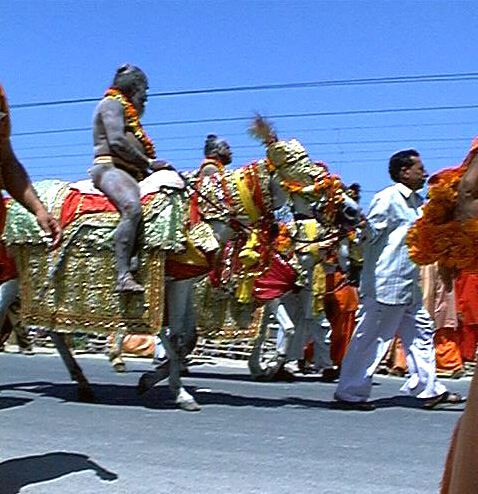
|
This is a site about the 1998 Kumbh Mela, but I have also published a list of links about the 2001 festival as well.
On 14 April 1998 ten million pilgrims bathed in the Ganges in Hardwar, India. This Web site will take you there.
On 6 February 1989 an estimated fifteen million pilgrims traveled to Allahabad in India on the occasion of the most recent full Kumbh Mela there. According to The Guiness Book of Records, this was the "greatest recorded number of human beings assembled with a common purpose" in history. The Kumbh Mela is held by turns in four different cities in India: Allahabad, Hardwar, Ujjain, and Nasik. The festival is conducted in each of these cities every dozen years or so. On 14 April 1998 the population of Hardwar in North India swelled to the breaking point with the addition of an estimated ten million pilgrims who had come to bathe in the Ganges. Hardwar is a town about a hundred miles north of Delhi in the Indian state of Uttar Pradesh.

PART OF THE KUMBH CAMP
The center of the pilgrimage in Hardwar is a large camp across the Ganges River from the main ghat. Prominent among the religious groups that regularly return to the Kumbh every twelve years are those from renunciant communities. On the main bathing day they lead pilgrims in the millions in a parade from the camp down to the ghat to bathe in the Ganges. The goal of the bathers at the Hardwar Kumbh Mela is a ghat of the Ganges known as the Brahma Kund, which is sometimes held to be a place where some of the ambrosia of immortality was spilled in the primeval tug of war between the gods and demons. As such, this would be a particularly propitious place to escape the pains of rebirth.

A RENOUNCER IN PROCESSION ON THE MAIN BATHING DAY
If you want to learn more about the 1998 Kumbh Mela in Hardwar, I will take you there. In this Web site you will find text and pictures about:
More information is available the background of the Kumbh Mela, and there are other Web sites about the festival that you might want to check out as well.
Contact with me with questions or comments at JEL807F@Missouri State.EDU.
J. E. Llewellyn
Department of Religious Studies
Missouri State
Springfield, Missouri 65804
U. S. A.
Acknowledgments: The research upon which this site is based was made possible by sabbatical support from Missouri State. Crucial technical assistance was provided by John T. Strong of Missouri State in Springfield, Pradeep Mehendiratta of the American Institute of Indian Studies in Delhi, and Mukul K. Hatwal of the Hardwar Development Authority in Hardwar.
Copyright J. E. Llewellyn 2001. Updated 4 September 2002.